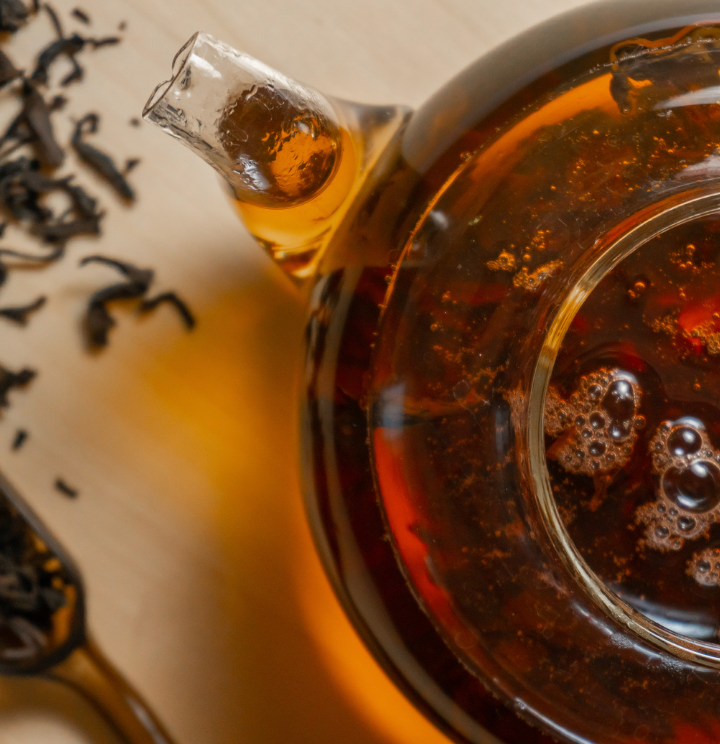Did you know that ‘English Breakfast’ tea is actually a mix of various other black teas to create a blend that pairs well with milk and sugar? Assam, Ceylon, and Keemum are often used together.
And if those names have got you stumped, read on, because there’s a whole complex, multi-layered world of black tea’s out beyond ‘English Breakfast’.
There are over 3,000 varieties including black tea’s like the fermented Pu-erh that can age for decades like fine wine, or the labour-intensive Yellow tea that’s fermented and repeatedly wrapped.
But where should you start?
We’re going to separate those 3,000 varieties of black teas into roughly three major categories, and highlight the key-players of each so that you can make an educated start in exploring beyond the classic English Breakfast.
Pure, unflavoured tea
These are teas that undergo traditional processing methods without any added flavours. A traditional processing method might include steps like plucking, withering (to reduce moisture), rolling (to shape and bruise the leaves), oxidising (where the leaves darken and develop flavour, distinctly shorter than the elongated oxidising phase of fermented tea), and drying to preserve them.
Assam tea comes from the Assam region in northeastern India, one of the largest tea-producing areas in the world. Known for its bold, malty flavour and deep amber colour, Assam tea is made from the Camellia sinensis var. assamica plant.

Darjeeling tea is grown in the misty, mountainous region of Darjeeling in the foothills of the Himalayas, India. Known as the "Champagne of Teas," Darjeeling is prized for its light, floral, and muscatel flavour, which can vary by season. Darjeeling is usually lighter in colour, and has limited production, making it somewhat sort after worldwide.
Keemun tea originates from the Qimen County in Anhui province, China, and is renowned for its rich, smooth flavour and fragrant aroma. Often described as having notes of dark chocolate, fruit, and a hint of smokiness, Keemun is considered one of the finest black teas in the world.
Flavoured or scented tea
These are often traditionally processed black teas (as above), but twisted with a cultural or creative flavour. You may be familiar with many of the classic flavours.
Chai, often referred to as ‘masala chai’ in India, is a spiced tea blend that combines strong black tea with a variety of aromatic spices and herbs. Traditional recipes typically include ingredients like cardamom, cinnamon, ginger, cloves, and black pepper, along with milk and sweetener, that are blended in the family home as part of a daily ritual.

Earl Grey is a distinctive black tea flavoured with oil of bergamot, a citrus fruit known for its fragrant aroma. Originating in England, it is named after Charles Grey, the 2nd Earl Grey, who was gifted a blend of tea flavoured with bergamot in the 1830s. The tea typically features a base of Chinese black tea, such as Keemun or Assam, and is often enjoyed plain or with milk and sugar.
Various other creative flavours such as our ‘dark and stormy’ cocktail inspired black tea twist, our aniseed-sweet licorice black, or our summery peach black.
Fermented, aged tea
Fermented and aged teas are unique categories of tea where microbial fermentation or oxidation transforms the tea leaves' tastes over time, resulting in complex and earthy flavours.
Pu-erh tea is a unique fermented tea from Yunnan province in China, known for its rich, earthy flavours and potential health benefits. Pu-erh undergoes a fermentation process that can last from several months to many years, resulting in complex, mellow flavours that deepen over time. It’s categorised into two types: "sheng" (raw) and "shou" (ripe), with sheng being aged naturally and shou undergoing an accelerated fermentation.

White tea can be aged for several years. While it’s not traditionally fermented like Pu-erh or Hei Cha, the natural ageing process leads to changes in flavour, developing deeper, more honeyed, and mellow characteristics over time.
If you’re new to the wide world of black tea, perhaps just expanding from English breakfast, then we would recommend starting with a creatively flavoured or scented tea, and then cutting back the flavour to an artisan black tea, and finally adventuring out into the fermented, aged teas.
Let us know what you want to try first!

